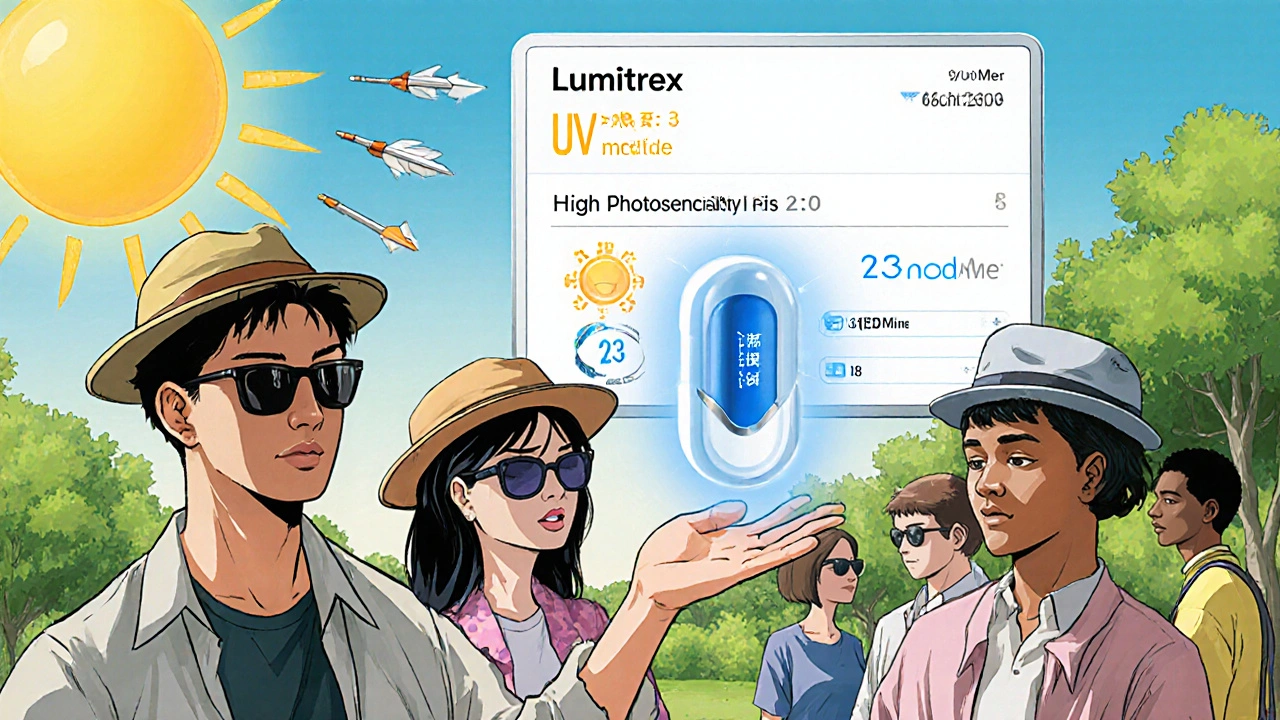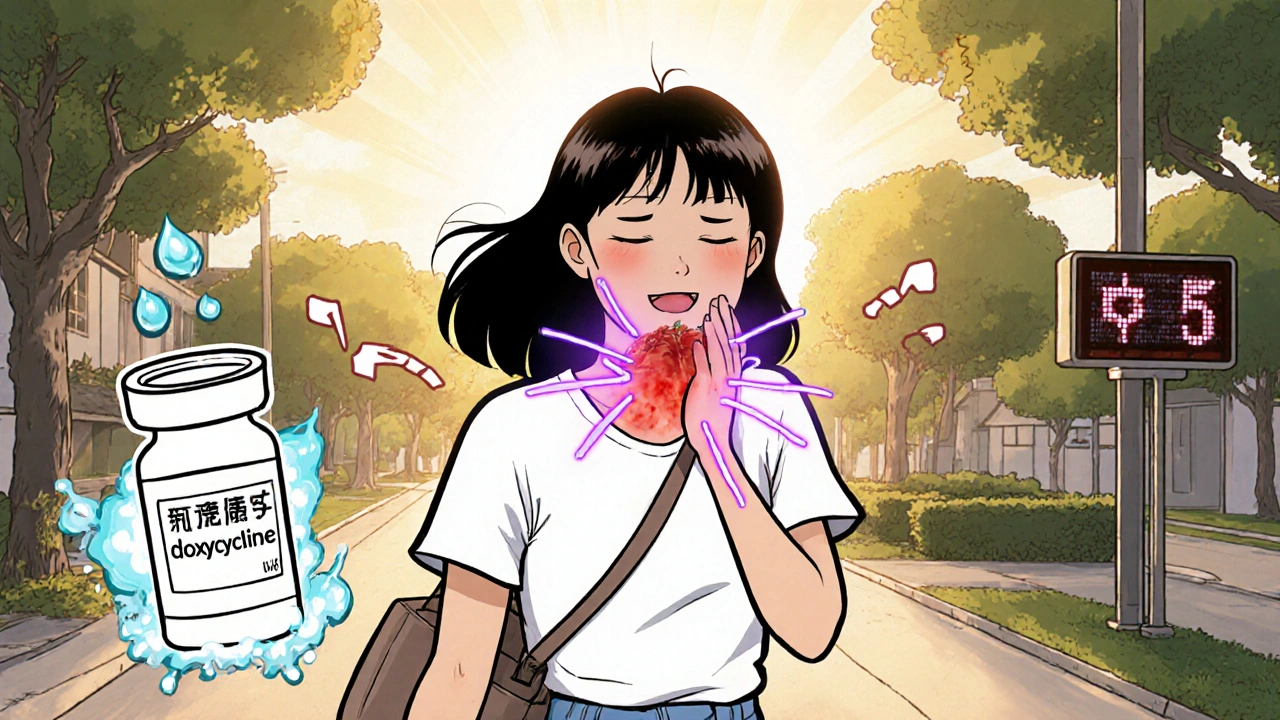Medication Photosensitivity Checker
Check Your Medication
Key Information
Over 1,000 medications can cause photosensitivity. This tool helps identify potential risks.
Always consult your doctor for medical advice.
Protection Recommendations
What to Do
More than 1,000 common medications can make your skin dangerously sensitive to sunlight. You might not know it until you get a bad sunburn after just a short walk outside - even through clothing. This isn’t just a bad tan. It’s photosensitivity, a real and often misunderstood side effect of drugs you’re likely already taking.
What Exactly Is Medication-Induced Photosensitivity?
Photosensitivity happens when a drug in your body reacts with ultraviolet (UV) light, especially UVA rays (320-400 nm), and triggers skin damage. It’s not an allergy in most cases. In fact, about 95% of reactions are phototoxic, meaning the drug turns into a harmful compound when hit by sunlight, burning your skin like a chemical burn. The other 5% are photoallergic, where your immune system overreacts to the drug-light combo, causing a delayed rash that can spread beyond sun-exposed areas. You might think you’re just getting sunburned easily. But if you’ve started a new medication and suddenly your neck, arms, or even the tops of your feet turn red, blister, or itch after minimal sun exposure, it’s probably not the sun’s fault - it’s the drug.Which Medications Cause the Worst Reactions?
Some drugs are far more likely to cause problems than others. The big offenders include:- Tetracyclines - Doxycycline, used for acne and infections, causes reactions in 10-20% of users. People often don’t realize it until they get burned during a quick errand.
- NSAIDs - Ketoprofen (found in some gels and pills) is a major trigger, especially in older adults using it for arthritis.
- Fluoroquinolones - Ciprofloxacin and levofloxacin, common antibiotics, can cause severe phototoxic burns.
- Amiodarone - Used for heart rhythm problems, this drug sticks in your skin for years. Up to 75% of long-term users develop lasting photosensitivity, even after stopping it.
- Sulfonamides and phenothiazines - Found in some diuretics, antipsychotics, and older antidepressants, these are common causes of photoallergic rashes.
Phototoxic vs. Photoallergic: How to Tell the Difference
Knowing the type helps you respond correctly.| Feature | Phototoxic Reaction | Photoallergic Reaction |
|---|---|---|
| Onset | 30 minutes to 2 hours after sun exposure | 24 to 72 hours after exposure |
| Appearance | Severe sunburn - red, swollen, blistered | Eczema-like rash - itchy, scaly, may spread |
| Location | Only sun-exposed skin (face, neck, hands) | Can spread to covered areas (under clothes) |
| Who gets it? | Anyone taking the drug + enough UV | Only those sensitized (0.1-0.5% of users) |
| Duration | Fades in days after stopping drug | Can last weeks; may recur with re-exposure |
Why Most Sunscreens Don’t Work - And What Does
Standard SPF 30 sunscreens? Often useless. Why? Because they’re designed to block UVB (the burning rays), not UVA (the aging and photosensitizing rays). The FDA says only 35% of SPF 50+ sunscreens offer enough UVA protection. That’s a huge gap. You need a sunscreen with:- SPF 50+ - Higher number means more UVB protection.
- Zinc oxide or titanium dioxide - Physical blockers that reflect UVA and UVB. Look for at least 15% zinc oxide.
- Broad-spectrum - Must say it on the label.

Clothing Is Your Best Defense
A regular white T-shirt only blocks 3-20% of UV rays. That’s barely better than nothing. UPF 50+ clothing blocks 98% of UV radiation. Brands like Solbari, Coolibar, and UV Skinz are designed for this. People who switch to UPF 50+ shirts, hats, and sunglasses report up to a 90% drop in reactions. Wear long sleeves, even on cloudy days. UVA penetrates clouds and glass. If you’re driving or sitting by a window, you’re still exposed.UV Index Matters - More Than You Think
You don’t need to be at the beach to get burned. A UV index of 3 or higher can trigger reactions in photosensitive people. That’s common in New Zealand even in winter. Use apps like UVLens or the SunSmart app to check real-time UV levels. If it’s 3 or above, plan outdoor time before 10 a.m. or after 4 p.m. Limit exposure to under 15 minutes if you’re on high-risk meds like doxycycline or amiodarone.Why So Many People Get Caught Off Guard
Here’s the truth: 68% of people on photosensitizing drugs get no warning from their doctor. Pharmacists rarely mention it. Online drug info often buries the warning under “side effects.” One pharmacist on Reddit shared how she got severe burns walking to her car after starting doxycycline - no one told her. Another user said their emergency room visit for a blistering rash was misdiagnosed as “sun poisoning.” Doctors miss up to 70% of these cases, confusing them with eczema or polymorphic light eruption. The fix? Ask your provider: “Could this medication make me sensitive to the sun?” If they say no, ask for the FDA’s list of photosensitizing drugs. They’re required to include warnings on 200+ medications now.
What to Do If You React
If you get a reaction:- Get out of the sun immediately.
- Cool the skin with damp cloths - no ice.
- Use aloe vera or hydrocortisone cream (1%) for itching.
- Take an antihistamine if it’s itchy and spreading (for photoallergy).
- Call your doctor. Don’t wait.
- Do not restart the medication without medical advice.
What’s New in 2025?
The field is changing fast:- Lumitrex - A new FDA-approved oral drug that reduces UV-induced skin damage by 70%. It’s not a sunscreen - it’s a protective agent taken before sun exposure.
- Smart sunscreens - Prototypes are testing color-changing formulas that signal when UV protection is wearing off.
- Genetic testing - Companies like 23andMe now offer a photosensitivity risk panel that checks for gene variants linked to higher sensitivity. If you’ve had repeated reactions, it might be worth testing.
Final Checklist: Sun Safety on Medications
If you’re taking any of these drugs - or even if you’re not sure - follow this:- Check your meds against the FDA’s photosensitivity list (search online: “FDA photosensitizing drugs list”).
- Use zinc oxide sunscreen (SPF 50+, minimum 15% zinc), reapplied every 2 hours.
- Wear UPF 50+ clothing, wide-brimmed hats, and UV-blocking sunglasses daily.
- Check the UV index before going outside. Avoid exposure if it’s 3 or higher.
- Limit direct sun to under 15 minutes during peak hours.
- Ask your pharmacist: “Is this drug known to cause sun sensitivity?”
- Keep a log: note which meds you’re on and any skin reactions after sun exposure.
Can I still go outside if I’m on a photosensitizing medication?
Yes - but you need to be extra careful. Avoid direct sun during peak hours (10 a.m. to 4 p.m.), wear UPF 50+ clothing, use zinc oxide sunscreen, and check the UV index daily. Short walks early in the morning or late afternoon are usually safe with proper protection.
Do I need to stop my medication if I get a sunburn?
Never stop a prescribed medication without talking to your doctor. Some reactions can be managed with better sun protection. But if you have severe burns, blistering, or recurring rashes, your doctor may switch you to a non-photosensitizing alternative. Your health depends on both treating your condition and protecting your skin.
Is SPF 30 enough if I’m on medication?
No. SPF 30 blocks about 97% of UVB rays, but most sunscreens at that level offer poor UVA protection. Since photosensitivity is triggered by UVA, you need SPF 50+ with zinc oxide or titanium dioxide. Many people think SPF 30 is enough - but for photosensitive skin, it’s not.
Can I use regular sunscreen with these medications?
Some ingredients in regular sunscreens - like oxybenzone - can actually cause photoallergic reactions themselves. Avoid chemical sunscreens with oxybenzone, avobenzone, or octocrylene. Stick to mineral sunscreens with zinc oxide or titanium dioxide as the only active ingredients.
How long does photosensitivity last after stopping the drug?
It depends on the drug. For most antibiotics, it fades within days to weeks. But for drugs like amiodarone, photosensitivity can last for years - even decades - because the drug builds up in skin and fat tissue. If you’ve taken amiodarone long-term, assume you’re still sensitive unless proven otherwise.
Are there any natural remedies for photosensitivity?
No natural remedy replaces sun protection. Antioxidants like vitamin C or green tea extract may help reduce free radical damage, but they don’t block UV rays. Relying on supplements instead of sunscreen or clothing puts you at serious risk of burns and skin cancer. Protection is physical - not nutritional.

It's wild how little most doctors talk about this. I've been on doxycycline for months and never thought twice about walking to my car. Got burned so bad I thought I had heat stroke. Turns out, it was the meds. I wish someone had warned me before I spent a week in pain.
Now I wear UPF 50+ shirts even indoors near windows. It's not sexy, but it's saved my skin.
Also, zinc oxide sunscreen is a game-changer. The chemical ones? They felt like I was slathering on poison.